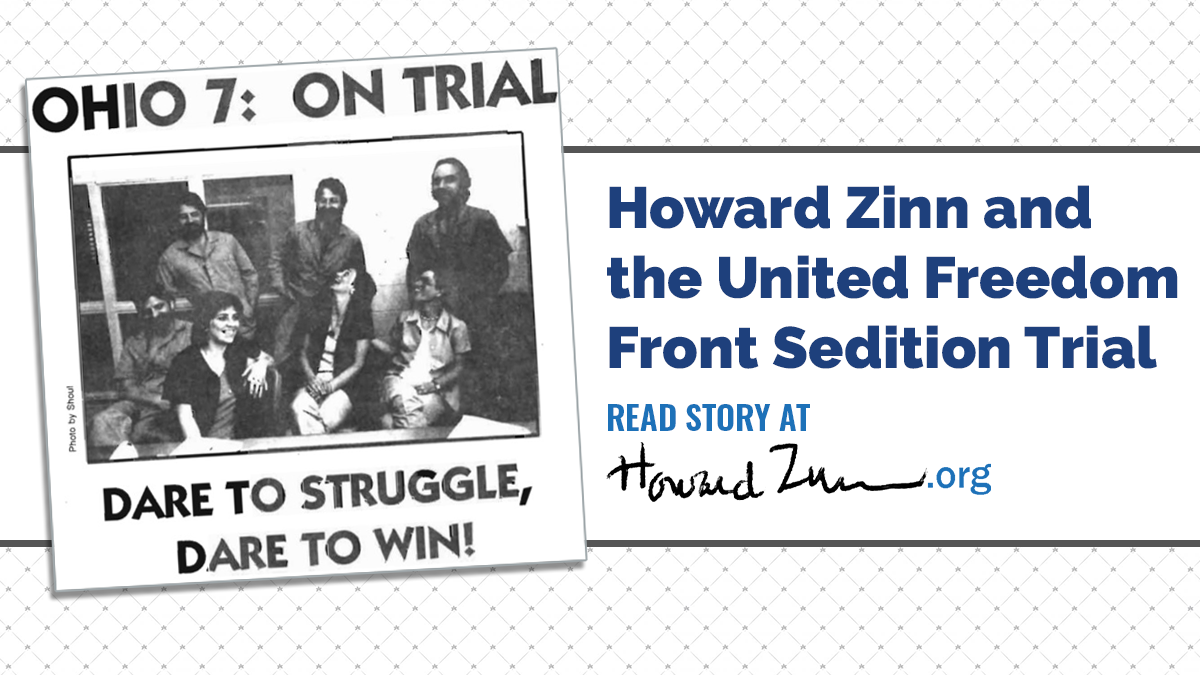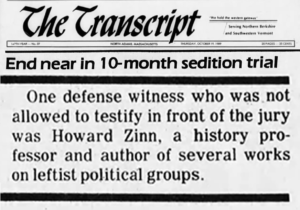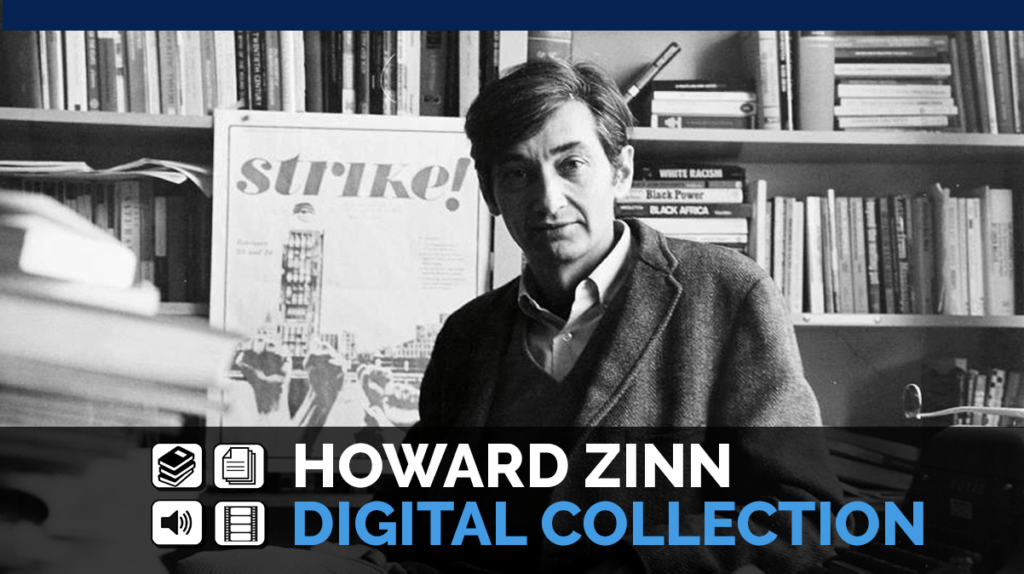 By Josh Davidson, member of the Certain Days: Freedom for Political Prisoners Calendar collective
By Josh Davidson, member of the Certain Days: Freedom for Political Prisoners Calendar collective
Special thanks to Ray Luc Levasseur and staff at the Robert S. Cox Special Collections & University Archives Research Center at the University of Massachusetts Amherst.
Throughout his career, Howard Zinn defended numerous people for their direct action, both in court and out. On October 18, 1989, Zinn took the stand in defense of the United Freedom Front, where he offered a definition of political prisoners. He said:
The term political prisoners has been long used in social movements because people who engage in social movements, radicals, socialists or people who commit civil disobedience of various kinds, people who are imprisoned for protesting a governmental policy, are considered political prisoners by the movements that they come out of and very often by people outside those movements who recognize that they’ve been in prison not for common crimes but in prison basically for their ideas or for social actions intended to bring about change.
The United Freedom Front (UFF) were a group of working-class revolutionaries who partook in armed struggle against U.S. imperialism in solidarity with freedom struggles in South Africa and throughout Central America in the 1970s and 1980s. In May 1986, eight members of the group were indicted and faced numerous state and federal charges. Those arrested were Kazi Toure, Carol Saucier Manning, Tom Manning, Richard Williams, Barbara Curzi-Laaman, Jaan Laaman, Patricia Gros Levasseur and Raymond Luc Levasseur. With the exception of Toure, seven of these members faced state charges and became known as the Ohio 7. The defendants in the Ohio 7 case were given lengthy prison sentences. According to a Toronto Anarchist Black Cross support zine distributed during the trials:
The Ohio 7 are charged by the U.S. government with 11 armed actions (i.e., bombings) and seditious conspiracy. They have already been convicted to varying degrees for the bombings, which were carried out against U.S. military facilities and recruiting offices, South African government offices, IBM, Union Carbide, Motorola, Honeywell, and General Electric. These actions were claimed by the United Freedom Front (UFF), and were in solidarity with the people of Azania (South Africa) and Central America. The Ohio 7 have never claimed nor repudiated these actions. . . They are now doing very lengthy sentences for these charges but are still going through trials, being charged again for these actions through “seditious conspiracy” charges.
All of the actions of the United Freedom Front were aimed at sabotaging corporations in the New York City area that bleed the people of all nations through the genocide of imperialism. These actions serve the purpose of making these corporations’ participation in oppression costly and more difficult. They also aid in creating a much needed resistance movement in the United States.
All eight of those arrested as part of the United Freedom Front were charged with seditious conspiracy to overthrow the government, racketeering, and conspiracy to engage in racketeering (RICO charges). This federal trial began in Boston and ended three years later at a federal courthouse in Springfield, Massachusetts. The trial was the longest and most expensive in Western Massachusetts history, lasting 19 months and costing the government an estimated $60 million. Of the eight indicted, two pleaded out (Kazi Toure and Carol Manning), three had their charges dismissed (Tom Manning, Jaan Laaman, and Barbara Laaman), and three stood trial (Richard Williams, Patricia Levasseur, and Ray Luc Levasseur). In November 1989, after 18 days of deliberations, the jury acquitted all three defendants of the sedition charge, but failed to reach a verdict on RICO charges, and in December the government decided to dismiss the charges rather than retry the defendants in another lengthy and costly trial.
The government prosecution – headed up by Robert Mueller – made a major blunder in charging us with sedition and RICO because you can’t be a radical/revolutionary (sedition) and also be a profit driven gangster (RICO). I was able to highlight this contradiction many times during trial. – Ray Luc Levasseur
Led by Robert Mueller, the prosecution called nearly 200 witnesses against defendants in this sedition trial. The defendants called 18 witnesses to the stand, including Howard Zinn, William Kunstler, and political prisoners Ed Mead and Sundiata Acoli. Several of these defense witnesses, including Howard Zinn, were prevented from testifying before the jury because the judge ruled their testimony “irrelevant.”

According to defendant Ray Luc Levasseur:
As this was Massachusetts, the trial judge immediately knew who Howard was and could also see from the way I’d been pressing things what we were looking to do (i.e., back door a necessity defense). So, he has a hearing outside the presence of the jury to see if he’ll allow Howard to testify (he did that with a number of our proposed defense witnesses). Howard gave great testimony at the hearing — essentially saying we were part of a historical tradition of resistance to the abominations of the system — and, in part, using UFF communiques to make the point! Of course, the judge ruled from the bench that Howard’s testimony would be “irrelevant.” Howard went out the door and held an impromptu news conference on the courthouse steps (you can do that when the media is steady hanging around the trial) and told them the first amendment stops at the courthouse door.
Howard Zinn’s testimony can be read at www.howardzinn.org/collection/united-freedom-front-sedition-testimony. Asked to define terms and phrases like anti-imperialism, “left wing language,” freedom fighters, “Death to Apartheid,” revolutionary resistance movements, “free all political prisoners and POWs,” and Grand Jury resistance, Zinn provided concise answers that upheld the need for revolutionary change. He said,
Deprived of political power, deprived of economic power, the only weapon that people have, the only instruments that people have in order to bring about change are the unity, the solidarity of getting together of people.
Released in 2004, Ray Luc Levasseur was asked by the University of Massachusetts, Amherst W. E. B. Du Bois Library to participate in a 2009 panel discussion entitled “The Great Western Massachusetts Sedition Trial: 20 Years Later.” Buckling to public pressure, the university rescinded its invitation to Levasseur. However, this pressure did not prevent Howard Zinn from sending an email to the university in support of Levasseur’s right to free speech. Video recordings of the panel discussion can be found at the Rosenberg Fund for Children YouTube page. In fact, Robert Meeropol says it was the Ohio 7 trial which compelled him to establish the Rosenberg Fund for Children “to provide for the educational and emotional needs of children whose parents have suffered because of their progressive activities and who, therefore, are no longer able to provide fully for their children.”
Jaan Laaman was the last of the United Freedom Front members to be released from prison in 2021, after 37 years. Both Tom Manning and Richard Williams passed away while still incarcerated.
Further information:
- They Never Crushed His Spirit: A Tribute to Richard Williams (Kersplebedeb, 2006)
- For Love and Liberty: Artist Tom Manning: Freedom Fighter, Political Prisoner (Freedom Archives, 2014, currently unavailable)
- Hauling Up the Morning: Writings and Art by Political Prisoners and Prisoners of War in the U.S. (The Red Sea Press, 1990)
- The Women of the Ohio 7 (zine)
- Read Levasseur’s opening and closing statements from the sedition trial
Find more zines and information about the United Freedom Front at The Freedom Archives.
Find more about Howard Zinn and prison abolition at the Zinn Education Project.
Author Bio: Josh Davidson is a member of the Certain Days: Freedom for Political Prisoners Calendar collective, founded in 2001 to raise awareness and funds for political prisoners held in North America, and he’s the editor of the book Rattling the Cages: Oral Histories of North American Political Prisoners (AK Press, 2023).



